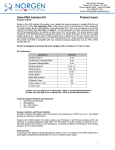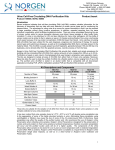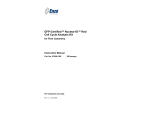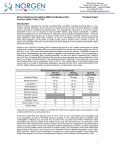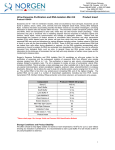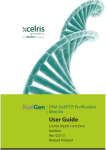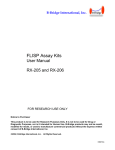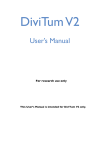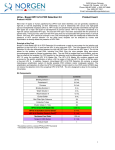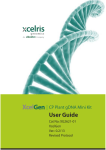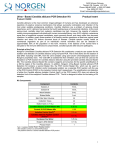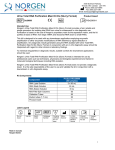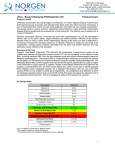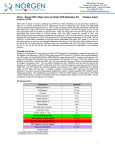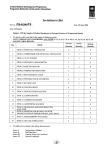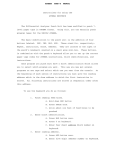Download Protocol (96-well) - Norgen Biotek Corp.
Transcript
3430 Schmon Parkway Thorold, ON, Canada L2V 4Y6 Phone: 866-667-4362 (905) 227-8848 Fax: (905) 227-1061 Email: [email protected] Urine DNA Isolation 96-Well Kit (Slurry Format) Product Insert Product # 27100 Norgen’s Urine DNA Isolation 96-Well Kit (Slurry Format) provides a fast, reliable and simple procedure for high throughput isolation of DNA from 3-25 mL urine samples. DNA found in urine can be divided into 2 basic categories. The larger species (genomic-DNA) is generally greater than 1 kb in size, and appears to be derived mainly from cells shed into the urine. The second species is smaller, generally between 150 and 250 bp (apoptotic-DNA), and derives, at least in part, from the circulation. The second species is also considered as an RNA/DNA hybrid as reported by Halicka et al., 2000. Both types of DNA can be isolated reliably using this kit. This kit is designed to process 96 samples of 3-25 mL of urine each. Typical yields of DNA isolated will vary depending on the input sample, with more concentrated samples tending to yield more DNA. Norgen’s Urine DNA Isolation 96-Well Kit (Slurry Format) can also be used for the isolation of viral DNA from urine. Preparation time for a single sample is less than 30 minutes. The purified urine DNA is compatible with PCR and Southern Blot analysis. This kit is designed to process 96 samples of 3-25 mL urine each Kit Components: Component Contents Slurry B1 2 x 22 mL Lysis Buffer A 2 x 30 mL Wash Solution A 2 x 38 mL Elution Buffer B 30 mL 96-Well Filter Plate 1 Adhesive Tape 1 96-Well Collection Plate 1 96-Well Elution Plate 2 Product Insert 1 Customer-Supplied Reagents and Equipment For Vacuum Format: o Vacuum manifold with vacuum pump capable of generating a minimum pressure of -650 mbar or -25 in. Hg (such as Whatman UniVac 3 Vacuum to Collect Manifold) o Sealing tape or pads For Centrifuge Format: o Centrifuge with rotor for 96-well plate assembly (such as Thermo Fisher IEC Centra CL3 series or Beckman GS-15R) Centrifuge with a swinging bucket rotor capable of 2000 RPM Micropipettors 96 – 100% ethanol 60C incubator 15 mL tubes 50 mL tubes Lysozyme (if bacterial gDNA isolation is needed) Proteinase K (20 mg/mL) (Optional) Storage Conditions and Product Stability o All buffers should be kept tightly sealed and stored at room temperature (15-25 C) for up to 1 year without showing any reduction in performance. It is recommended to warm up Slurry B1 and Lysis Buffer A for 20 o minutes at 60 C if any salt precipitation is observed. Slurry B1 contains a grey resin that will not dissolve when warmed. 1 Quality Control In accordance with Norgen’s Quality Management System, each lot of Norgen’s Urine DNA Isolation 96-Well Kit (Slurry Format) is tested against predetermined specifications to ensure consistent product quality. Product Use Limitations Norgen’s Urine DNA Isolation 96-Well Kit (Slurry Format) is designed for research purposes only. It is not intended for human or diagnostic use. Product Warranty and Satisfaction Guarantee NORGEN BIOTEK CORPORATION guarantees the performance of all products in the manner described in our product manual. The customer must determine the suitability of the product for its particular use. Safety Information Ensure that a suitable lab coat, disposable gloves and protective goggles are worn when working with chemicals. For more information, please consult the appropriate Material Safety Data Sheets (MSDSs). These are available as convenient PDF files online at www.norgenbiotek.com. CAUTION: DO NOT add bleach or acidic solutions directly to the sample-preparation waste. Lysis Buffer A contains guanidinium salts, and should be handled with care. Guanidinium salts form highly reactive compounds when combined with bleach, thus care must be taken to properly dispose of any of these solutions Procedure Notes prior to use: We recommend the use of Norgen’s Urine Preservative when collecting urine samples, which is designed for the preservation of nucleic acids and proteins in fresh urine samples at ambient temperatures. The components of the Urine Preservative allow samples to be stored for over 2 years at room temperature with no detected degradation of urine DNA, RNA or proteins. Norgen’s Urine Preservative is available in 2 convenient formats: in a liquid format in Norgen’s Urine Preservative Single Dose Ampules, as well as in a dried format in Norgen’s Urine Collection and Preservation Tubes. Please see the Related Products table below. Do not spin down or filter the urine sample before proceeding with the isolation, as this could decrease the DNA yield. Ensure that all solutions are at room temperature prior to use, and that no precipitates have formed. If necessary, warm the solutions and mix well until the solutions become clear again. Slurry B1 contains grey resin that will not disappear when warmed. 7 Prepare a 400 mg/mL stock solution (approximately 1.7 x10 units/mL) of lysozyme as per supplier's instructions if bacterial gDNA isolation is needed Preheat an incubator or heating block to 60C. Prepare a working concentration of the Wash Solution A by adding 90 mL of 96-100% ethanol (provided by the user) to the supplied bottle containing the concentrated Wash Solution A. This will give a final volume of 128 mL. The label on the bottle has a box that may be checked to indicate that the ethanol has been added. Urine DNA isolation can be performed using either a vacuum manifold or centrifugation. For purification using vacuum, please follow the procedure outlined in Section A. For purification using centrifugation, please follow the procedure outlined in Section B. Urine inputs of 3 to 25 mL can be processed using either of the procedures outlined below. A. Detailed Procedure Using Vacuum Manifold 1. Add 300 L of Slurry B1 to each urine sample. Mix well by vortexing for 10 seconds. (Note 1: Slurry B1 must be mixed well before every pipeting) (Note 2: The volume of Slurry B1 is fixed with all urine volumes ranging from 3 mL and up to 25 mL) 2. Centrifuge for 2 minutes at 2,000 RPM, then discard the supernatant carefully in order not to dislodge the precipitated slurry pellet. 2 3. Option 1: To Isolate bacterial gDNA with the human DNA Add 12 L of the previously prepared lysozyme to the precipitated slurry pellet. Vortex for 10 seconds. Incubate the mixture at 60C for 20 minutes then proceed to Step 4. Option 2 : Urine samples which contain large amounts of protein In case your urine sample contains large amount of proteins a Proteinase K treatment can be done at this step. Add 50 L of 20mg/mL Proteinase K to the precipitated slurry pellet. Vortex for 10 seconds. Incubate the mixture at 60C for 20 minutes then proceed to Step 4. Option 3: Proceed directly to Step 4 if Option 1 or Option 2 is not required. 4. Add 500 L Lysis Buffer A to the precipitated slurry pellet, mix well by vortexing for 10 seconds. 5. Add 500 µL of 96-100% Ethanol to the mix from Step 4, mix well by vortexing for 10 seconds. 6. Assemble the 96-Well Filter Plate and the vacuum manifold according to manufacturer’s recommendations. (Note: The provided 96-Well Collection Plate can be used as the collection/waste tray if desired). 7. Transfer 650 µL of the mixture from Step 5, including all resin, into a well of the 96-Well Filter Plate. 8. Tape the plate or any unused wells using sealing tape or pads (provided by the user) according to the vacuum manifold manufacturer’s recommendations. Apply vacuum for 4 minutes. Turn off vacuum and ventilate the manifold. Discard the flowthrough. Reassemble the 96-Well Filter Plate and the vacuum manifold. 9. Repeat Step 7 and Step 8 to transfer the rest of the mixture from Step 5 10. Apply 400 µL of Wash Solution A to each used well of the 96-Well Filter Plate. Tape the plate or any unused wells using sealing tape or pads (provided by the user) according to the vacuum manifold manufacturer’s recommendations. Apply vacuum for 3 minutes. Turn off vacuum and ventilate the manifold. Discard the flowthrough. 11. Repeat Step 10 to wash the used well a second time. 12. Apply 400 µL of Wash Solution A to each used well of the 96-Well Filter Plate. Tape the plate or any unused wells using sealing tape or pads (provided by the user) according to the vacuum manifold manufacturer’s recommendations. Apply vacuum for 3 minutes. Turn off vacuum and ventilate the manifold. Discard the flowthrough. 13. Pat the bottom of the 96-Well Filter Plate dry. Reassemble the 96-Well Filter Plate and the vacuum manifold. Apply vacuum for an additional 5 minutes in order to completely dry the plate. Turn off vacuum and ventilate the manifold. 14. Replace the collection/waste tray in the vacuum manifold with a provided 96-Well Elution Plate. Complete the vacuum manifold assembly with the 96-Well Filter Plate. Add 100 µL of Elution Buffer B to each used well of the plate. Apply vacuum for 3 minutes. 15. Replace the used 96-Well Elution Plate in the vacuum manifold with the provided second 96-Well Elution Plate. Complete the vacuum manifold assembly with the 96-Well Filter Plate. Add 100 µL of Elution Buffer B to each used well of the plate. Apply vacuum for 3 minutes. Urine DNA is now ready for downstream applications. B. Detailed Procedure Using Centrifugation 1. Add 300 L of Slurry B1 to each urine sample. Mix well by vortexing for 10 seconds. (Note 1: Slurry B1 must be mixed well before every pipeting) (Note 2: The volume of Slurry B1 is fixed with all urine volumes ranging from 3 mL and up to 25 mL) 3 2. Centrifuge for 2 minutes at 2,000 RPM, then discard the supernatant carefully in order not to dislodge the precipitated slurry pellet. 3. Option 1: To Isolate bacterial gDNA with the human DNA Add 12 L of the previously prepared lysozyme to the precipitated slurry pellet. Vortex for 10 seconds. Incubate the mixture at 60C for 20 minutes then proceed to Step 4. Option 2 : Urine samples which contain large amounts of protein In case your urine sample contains large amount of proteins a Proteinase K treatment can be done as this step. Add 50 L from 20mg/mL Proteinase K to the precipitated slurry pellet. Vortex for 10 seconds. Incubate the mixture at 60C for 20 minutes then proceed to Step 4. Option 3: Proceed directly to Step 4 if Option 1 or Option 2 is not required. 4. Add 500 L Lysis Buffer A to the precipitated slurry pellet, mix well by vortexing for 10 seconds. 5. Add 500 µL of 96-100% Ethanol to the mix from Step 4, mix well by vortexing for 10 seconds. 6. Place the 96-Well Filter Plate on top of a provided 96-Well Collection Plate. 7. Transfer 650 µL from the mixture from Step 5, including all resin, into a well of the 96- Well Filter Plate. 8. Centrifuge the assembly at maximum speed or 2,000 RPM for 2 minutes. Discard the flowthrough. Reassemble the 96-Well Filter Plate and the 96-Well Collection Plate. 9. Note: Ensure that all of the lysate from each well has passed through into the bottom plate. If the entire lysate volume has not passed, centrifuge for an additional 2 minutes. Repeat Step 7 and Step 8 to transfer the rest of the mixture from Step 5 10. Apply 400 µL of Wash Solution A to each used well of the 96-Well Filter Plate. Centrifuge the assembly at maximum speed or 2,000 RPM for 2 minutes. Discard the flowthrough. Reassemble the 96-Well Filter Plate and the bottom plate. Note: Ensure the entire Wash Solution A has passed through into the bottom plate by inspecting the 96-Well Filter Plate. If the entire wash volume has not passed, centrifuge for an additional 2 minutes. 11. Repeat Step 10 to wash the used wells a second time. 12. Apply 400 µL of Wash Solution A to each used well of the 96-Well Filter Plate. Centrifuge the assembly at maximum speed or 2,000 RPM for 2 minutes. Discard the flowthrough. Reassemble the 96-Well Filter Plate and the bottom plate. 13. Pat the bottom of the 96-Well Filter Plate dry. Reassemble the 96-Well Filter Plate and the bottom plate. Centrifuge the assembly at maximum speed or 2,000 RPM for 5 minutes in order to completely dry the plate. 14. Stack the 96-Well Filter Plate on top of one of the provided 96-Well Elution Plates. Add 100 µL of Elution Buffer B to each used well of the plate. Centrifuge the assembly at maximum speed or 2,000 RPM for 2 minutes. 15. Replace the used 96-Well Elution Plate with the second provided 96-Well Elution Plate. Add 100 µL of Elution Buffer B to each used well of the plate. Centrifuge the assembly at maximum speed or 2,000 RPM for 2 minutes. Urine DNA is now ready for downstream applications. 4 Rapid Flow Chart Procedure Using Vacuum Manifold 3mL - 25 mL urine Sample Add 0.3 mL Slurry B1 (Solution A must be mixed well before every pipeting) Vortex for 10 seconds SPIN 2,000 RPM, 5 min Discard Supernatant Add 0.5mL Lysis Buffer A Vortex for 10 seconds Add 0.5mL 96-100% Ethanol Vortex for 10 seconds Mix, transfer 650µL into each well of the 96- Well Filter Plate (transfer twice) Vacuum, 4 minutes Wash three times with 400 µL Wash Solution A Vacuum, 3 minutes Dry by Vacuum, 5min Elute DNA with DNA Elution Buffer B E1 (100 µL) E2 (100 µL) Vacuum, 3 min Purified Total DNA 5 Rapid Flow Chart Procedure Using Centrifugation 3mL - 25 mL urine Sample Add 0.3 mL Slurry B1 (Solution A must be mixed well before every pipeting) Vortex for 10 seconds SPIN 2,000 RPM, 5 min Discard Supernatant Add 0.5mL Lysis Buffer A Vortex for 10 seconds Add 0.5mL 96-100% Ethanol Vortex for 10 seconds Mix, transfer 650µL into each well of the 96- Well Filter Plate (transfer twice) Centrifuge, 2 minutes at 2,000 RPM Wash three times with 400 µL Wash Solution A Centrifuge, 2 minutes at 3,000 RPM Dry by Centrifugation, 5 minutes at 3,000 RPM Elute DNA with DNA eEution Buffer B E1 (100 µL) E2 (100 µL) Centrifuge, 2 minutes at 3,000 RPM Purified Total DNA 6 Frequently Asked Questions 1. If I am not going to process my samples immediately, how should I store my samples? We recommend the use of Norgen’s Urine Preservative when collecting urine samples, which is designed for the preservation of nucleic acids and proteins in fresh urine samples at ambient temperatures. Urine samples in the preservative should be stored at room temperature. Turbidity or precipitation may be observed if the urine samples are stored at either 4C or at -20C. DO NOT discard this precipitate and/or spin down your samples to get rid of the turbidity; this will significantly reduce your DNA yields. Make sure to mix your samples thoroughly before processing. 2. What If a variable speed centrifuge is not available? A fixed speed centrifuge can be used, however reduced yields may be observed. 3. What will happen if my centrifugation speed varied from the recommended speed? This may lead to the degradation of the genomic DNA or reduction in the total DNA yields. 4. At what temperature should I centrifuge my samples? All centrifugation steps are performed at room temperature. Centrifugation at 4C will not adversely affect kit performance. 5. What If I added more or less of the specified reagents’ volume? Adding more or less from the specified volume may affect the quality and the quantity of the isolated DNA. 6. What If I forgot to do a dry spin after my second wash? Your first DNA elution will be contaminated with the Wash Solution A. This may dilute the DNA yield in your first elution and it may interfere with your downstream applications. 7. Can I perform a third elution? Yes, you can. A third elution is possible, but it is recommended that this elution is performed in a smaller volume (50 L). 8. Why do my samples show very low DNA yield? Some urine samples contain very little DNA. This varies from individual to individual based on numerous variables. In order to increase the yield, the amount of urine input could be increased. 9. Why does my DNA does not perform well in downstream applications? If a different Elution Buffer B was used other than the one provided in the kit, the buffer should be checked for any components that may interfere with the application. Common components that are known to interfere are high salts (including EDTA), detergents and other denaturants. Check the compatibility of your Elution Buffer B with the intended use. 10. What is the expected DNA yield from urine? The urinary DNA yield varies between individual samples. Generally the DNA yield ranges between 50 ng – 2 µg/mL of urine sample. Sometimes the DNA yields from urine are too low to be visualized on an agarose gel; however, the DNA yield is sufficient for most of the downstream applications including PCR and Southern hybridization. 7 Related Products Urine DNA Isolation Kit Product # 18100 Urine DNA Isolation Kit for Exfoliated Cells or Bacteria 47050 Urine Collection and Preservation Tubes (50 cc) – 1 tube, 50 tubes 18111, 18113 Urine Collection and Preservation Tubes (15 cc) – 1 tube, 50 tubes 18120, 18122 Urine Collection and Preservation Tubes (5 cc) - 1 tube, 50 tubes 18116, 18118 Urine Preservative Single Dose – 1 tube, 50 tubes 18124, 18126 Technical Assistance NORGEN’s Technical Service Department is staffed by experienced scientists with extensive practical and theoretical expertise in sample and assay technologies and the use of NORGEN products. If you have any questions or experience any difficulties regarding Norgen’s Urine DNA Isolation 96-Well Kit (Slurry Format) or NORGEN products in general, please do not hesitate to contact us. NORGEN customers are a valuable source of information regarding advanced or specialized uses of our products. This information is helpful to other scientists as well as to the researchers at NORGEN. We therefore encourage you to contact us if you have any suggestions about product performance or new applications and techniques. For technical assistance and more information, please contact our Technical Support Team between the hours of 8:30 and 5:30 (Eastern Standard Time) at (905) 227-8848 or Toll Free at 1-866-667-4362. or call one of the NORGEN local distributors (www.norgenbiotek.com) or through email at [email protected]. References Halicka, H. D., Bedner, E. and Darzynkiewicz, Z. (2000). Segregation of RNA and separate packaging of DNA and RNA in apoptotic bodies during apoptosis. Exp Cell Res. 260, 248-256. M. Abdalla and Y. Haj-Ahmad. (2006).Urinary Proteomic and Genomic Profiles from Hepatitis C virus, Hepatitis B Virus, and Hepatocellular Carcinoma Patients. Molecular & Cellular Proteomics. ASBMB, S369 3430 Schmon Parkway, Thorold, ON Canada L2V 4Y6 Phone: (905) 227-8848 Fax: (905) 227-1061 Toll Free in North America: 1-866-667-4362 ©2014 Norgen Biotek Corp. PI27100-7-M14 8








